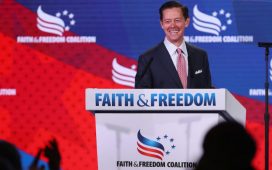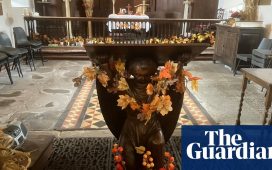The way the school saw it, it was devil worship.
In October 2019, three teenage girls were punished for participating in a spiritual ceremony. Their Arizona school expelled two of them, and let the third off with a warning, citing their attendance as a violation of school policy and grounds for expulsion.
Caitlyn, now 18, says she and her friends were disciplined for participating in a Sunrise Dance, a traditional Native ceremony at the core of White Mountain Apache culture.
The Monday after the dance, Caitlyn’s parents told her to stay home that day. They had received a call from East Fork Lutheran school telling them not to send their daughter in. She didn’t know why. Then around noon, her mom got another phone call. The principal wanted to meet with Caitlyn, her parents and the local preacher. The principal and preacher also invited the two other girls and their families to their own private meetings with school leadership.
At the start of each meeting, the families were chastised for participating in the dance. Caitlyn remembers her mother telling the principal and preacher how hypocritical they were to say the Apache people were not praying to God. “In the Bible, God himself says to come to me in all sorts,” she argued. “The dance is also a prayer; it’s another way.”
The leadership of the school, on the Fort Apache Reservation, disagreed with that interpretation and used pictures of the event posted on Facebook as evidence for their expulsions.
The other two girls were immediately given letters of expulsion. Caitlyn was just given a warning. “I knew that I was already one of the principal’s favorites,” she says. “I think they just gave me a second chance, but they gave me a strong warning not to have a dance.”
For the first 12 years of her life, Caitlyn looked forward to having her own dance – a sacred coming-of-age experience celebrating the transition from girlhood to womanhood. It’s a great financial sacrifice for the family. Over four days, a girl’s community prays for her. They offer her gifts and witness her as she participates in rituals symbolizing her maturity and growth. A medicine man presides over the event, praying and singing with holy members of the community called Crown Dancers, who recite the creation story to the audience.
The idea meant the world to Caitlyn. But she didn’t have her own Sunrise Dance: if she were found out, she would be expelled from school immediately, a stain on on her permanent record that could affect her college opportunities.
At the time, her private school’s teachers were mostly white people who would often discuss the satanic nature of Apache traditions. When Caitlyn was in fifth grade, she was given an F on an art project for drawing the White Mountain Apache crest and including an eagle feather. An “A” student, she was devastated to be chastised this way. As Caitlyn remembers it, her teacher smiled and explained that this kind of project wasn’t allowed because it denoted “pagan worship”. Her father was furious but the family couldn’t do anything about it. It was what the girl and her family expected from the white people who worked on the reservation.
But these expulsions felt different. Watching other girls get publicly exiled from their school community meant that fear soon took root, cracking the foundation of Apache pride her family had worked to build beneath her.
Caitlyn finished her eighth-grade year at East Fork Lutheran school and then moved on to a school off the reservation, but the damage was done. For the next four years, Caitlyn struggled to integrate into her Apache culture. She explained: “I didn’t allow myself to engage or talk about my culture,” she says. “Even after I graduated, I had that paranoia that I would get in trouble for talking about or participating in it.”
Three and a half years after the expulsions, in early 2023, nine women gathered in the front room of a small house on the Fort Apache Indian Reservation to talk about this pattern of expulsions.
In the middle of the room, two recording devices lay on opposite ends of the table. Abby, an older White Mountain Apache woman with her hair in a loose bun, hosted the evening. She sat down next to the black cast iron stove which had been lit hours before to keep the room warm and texted her sisters, Millie and Althea, who were coming.
Various women walked through her front door. Some were family members, others acquaintances. Nine women gathered to finally talk about what kept happening at East Fork Lutheran school.
Althea, the oldest of the sisters, spoke first. Two of her granddaughters were expelled from school in 2018 and 2019. She still has one of the school’s letters tucked away in a box in her house.
It states that these 13-year-old girls will only be allowed to return to school if they agree to confess in front of the Wels church, school and community that they were worshiping the devil when they took part in the Sunrise Dance. They must promise never to do it again.
Maria, a younger woman in her late 30s, was there to share a similar story. The school board found that she had also participated in what they considered a satanic ceremony. Her children were not allowed to return to school the next year. The school had decided to penalize the children for the perceived sins of their mother.
Astonishingly, this pattern of Christian discipline, started more than a century ago, had never stopped.
A ‘demonic manifestation’
The Fort Apache Reservation in Arizona spans 2,625 square miles – just a little larger than the state of Delaware, but with a population just over 14,600.
Based on our reporting and speaking with members of the tribe, there are over 80 churches on the reservation, representing 27 different Christian denominations. The tribe indicated that there was an official list the churches operating on the reservation but no list has been delivered.
East Fork Lutheran school was founded in 1951 by the Wisconsin Evangelical Lutheran Synod (Wels), a religious group which has been active in Arizona since 1893 as part of its Apache Mission – an effort to convert “unreached tribes” to Christianity. This was one of many schools built on the reservation by Wels. The mission has shifted to now being focused on training Native American Christians to lead in the ministry and serve as missionaries to other Indigenous nations throughout the US and Canada.
The school is not unique in its dogma opposing traditional Indigenous practices; the vast majority of the churches on Apache land teach families who participate in traditional ceremonies that they’re damning themselves by worshiping the devil. The Whiteriver Assembly of God, a Pentecostal church, stated in its missionary handbook that Crown Dancers – those who help welcome the girl into womanhood during the Sunrise Dance – could be a “demonic manifestation”.
Since 2020, Wels has published 180 sermons on its YouTube channel, Native Christians. Thirty-one of the 190 videos – almost a fifth – include disparaging remarks about tribal practices including the Sunrise Dance or medicine men, including two completely dedicated to convincing the congregation of the evil within the Sunrise Dance.
Only two Christian denominations operating on the reservation told me they do not include anti-traditional-Apache rhetoric in their sermons and ideology: the Catholic church and the Church of Jesus Christ of Latter-day Saints, also known as the Mormon church. Families on the reservation commonly have a similar understanding.
The influence of this religious teaching throughout the community affects the tribal government as well. Less than half of the 11-person White Mountain Apache tribal council participates in Apache ceremonies, according to the councilmember Annette Tenijieth. She believes seven council people do not participate in Sunrise Dances or support the work of medicine men.
Apache families who send their children to the East Fork Lutheran school face a complicated choice. Some families do so because students in Christian schools are seen as more successful than those attending the Bureau of Indian Affairs (BIA) schools down the road. Others simply value a Christian education, and feel that their children might get on the “right path” with that background.
Still, many families have their children participate in Native ceremonies, ignoring the school’s racist policies. They just hope they do not get found out by the teachers.
‘Mom, did you know you are worshiping false idols?’
“One would think that a story like this would be out of 1890, not 2024.”
When I talked to Dr Robert P Jones, the president and founder of the Public Religion Research Institute (PRRI), a non-profit, non-partisan organization, he was dismayed that churches still teach against Indigenous tradition.
“It is worth noting that the posture being described comes from this conviction that European Christianity is the pinnacle of human civilization,” he said. “And anything other than that is inferior and worse religiously because it can lead you to eternal damnation.”
The Sunrise Dance is a celebration of puberty endowing girls with blessings from God and their community. It is one of the few Apache rituals that has survived the Indigenous genocide that resulted in the death of as many as 15 million Native Americans over the last 500 years.
The dance is sacred both because of its origin and the spiritual impact it has on a girl’s life.
Bruce Burnette, a White Mountain Apache medicine man – a spiritual leader endowed with traditional knowledge of healing – oversees these dances. Burnette explained:“It’s about the girl. The Sunrise Dance is not for today, not for tomorrow. It is fixing the room for her, fixing the road to success. The reason why it is so important is that a woman has got to be strong to move on the path to what she is going to become.”
According to Burnette, the dance came in a vision to an early medicine man. The ceremony has remained the same through the generations.
“The prayer that is put down for her is that it would be easy for her, that it would be comfortable for her in whatever she wants [to do],” Burnette said. “If she wants to go to military life, school, or look to find a job – everything will be there to be successful. That is the prayer that is put down.”
Maria’s crime, as the school saw it, was that she sponsored a Sunrise Dance – never mind that it took place on the weekend and off school grounds. In doing so, she helped welcome a friend’s daughter into adulthood and created a familial bond for the rest of her life, which is a huge honor. But just before the school year started, she received an email telling her that her children were not allowed to return.
Maria had sent her children to East Fork because she hoped a Christian education would harmoniously supplement the foundation of their Indigenous heritage and identity; she now realized that East Fork was extreme in its anti-traditionalism.
She was devastated. During our interview, she cried as she explained the shame her daughters felt at not being allowed to go back to school. They were also nervous about being sent to the Bureau of Indian Affairs school, where the classes were bigger and they didn’t know anyone.
Just last year, the youngest of her three children attending the school came home from East Fork and asked: “Mom, did you know that when you go to Sunrise Dances, you are worshiping false idols?”
Maria was shocked. “Who told you that?” she asked.
“My teacher. She said watching the Crown Dancers is worshiping Satan.”
To hear this – and for her daughters to be told such insulting falsehoods – was mind-blowing. “Our ceremonies are what we were blessed with, our language, our everything,” Maria said. “Those are the things we were blessed with to be Apache people. So I try to explain it to them in a way where they understand: no, we’re not doing anything bad here. We’re not.”
Maria described feeling powerless – like she was hitting a wall in speaking to church leaders. (The Guardian received no answer from Wels after asking about Maria’s experience.)
All the while, her kids were wading in uncertainty about the nature of their cultural identities. Were they evil if they participated in ceremonies, or was it permitted? Who was right?
“I felt like the longer I kept them at the school, the more confused they were,” Maria said.
Still, she hoped to keep them there because the classroom setting was good. The student-to-teacher ratio was small. They received guaranteed attention by their teachers and a thorough education.
When it came time for registration, Maria did not receive any notification from the school. It finally notified her two weeks before the school year started that her children would not be invited back. She had to move them to the public school. “Now that they’re in a public school, and they’ve adjusted to it, they are more proud of their traditions or culture, they’re more proud of who they are,” she said.
A Wels spokesperson responded to requests for comment by saying, “Wels churches serve people by proclaiming the entirety of God’s message to us as presented in the Bible. Apache members, teachers and pastors have been faithful leaders as our Wels churches strive to present God’s truth among communities with their own valued religious practices. Wels has had a trusted partnership with members of the White Mountain Apache Tribe in sharing the message of the Bible dating back to 1893.”
Maria and her family no longer attend church. Though they are still devoted Christians, they’re not comfortable in that space. “Rather than giving a lecture about the Bible, the preachers bring it back to culture – ‘You’re not supposed to be doing this. You’re not supposed to be doing that,’” she explained.
Even the programs handed out at the beginning of the service have an unwelcome message written on the front: it states that if you have participated in a Sunrise Dance, you cannot take communion.
‘Kill the Indian in him, and save the man’
In August 2022, the Oglala Lakota Nation in South Dakota voted to kick out a missionary from the Pine Ridge Reservation who was distributing anti-traditional proselytizing materials. The nation now requires all missionaries and religious groups to register and go through a background investigation before entering the reservation and working.
No Indigenous nations in Arizona have publicly enacted these same regulations for a myriad of reasons – one being the short-term welfare perks of having religious groups freely operating on the reservation. Religious groups bring in donations, food and clothes to a population impoverished by crippling racist policies and the psychological legacy of genocide and spiritual abuse. The price for these benefits can include being forced to let go of tradition and Indigenity.
Tenijieth, the councilmember, explained that the White Mountain Apache Tribe is caught in a difficult position when it comes to expelling Wels from East Fork. “We can take that land back if we want to, but nobody has brought it up because there is a school there,” she explained. “Even though they are twisting the children’s minds, it is still a better school than others. We need to stand strong. Keep your language strong. Teach your children how to speak Apache … that’s the reason why we’re a sovereign nation.”
There is a straight line between the beliefs that underwrote Christopher Columbus’s claims to the Americas and the current attitudes of religious leaders on the reservation.
Columbus modeled the essence of the 1493 papal decree the doctrine of discovery, which consecrated any “new” territory not yet inhabited by Christians for the Christian world. When Columbus landed in the Americas, he claimed it for both Catholicism and Spain, officially intertwining religion with real estate.
In 1845, the doctrine of discovery was reminted for the country’s largely Protestant population as the doctrine of manifest destiny – the spiritual right for new Americans to expand westward and claim all territory in the name of “progress”.
Year after year, new policies were drafted to ensure that the Indigenous nations already living westward would help keep pioneers who chose to cross the Mississippi River safe. Treaties were signed under the illusion that the US government would honor land rights and cultural identity.
But in 1883, the Office of Indian Affairs, within the Department of Interior, established the Code of Indian Offenses, making it illegal to participate in traditional ceremonies. It wasn’t until 1978, with the passing of the American Indian Religious Freedom Act, that participating in the Sunrise Dance was decriminalized.
The establishment of the Office of Indian Affairs paved the way for the 1887 Dawes Act, which divided tribal lands into allotments and included a provision that entitled religious organizations that worked with Indigenous people to keep up to 160 acres of federal land to support their missions.
To this day, these churches still draw from the spiritual legacies of Christian missions and receive funding from off-reservation congregations under that definition. Global Ministries of the United Methodist church spent over $11m in 2022 for missionary services. Wels spent $661,018 just for the Apache missions and over $23.5m for all missions, as laid out in its most recent report, from 2023.
Wels first came to Arizona in 1892, five years after the Dawes Act. When it was clear that exterminating the Apache people would not be possible, the federal government engaged Christian denominations working with the military to force the assimilation of the Indigenous people. RH Pratt, the superintendent of the first “industrial” boarding school under this policy, coined the term that embodied the philosophy behind these institutions: “Kill the Indian in him, and save the man.”
Federal boarding school policy allowed the military to forcibly remove Apache children from their families and send them to industrial schools in an attempt to militarize and alter their identities. They were forbidden to practice their religion or speak their language, and reports of physical and sexual abuse were common. Many children never returned home.
If an Indigenous child was found outside during school hours, Indigenous police were appointed to snatch the child and deliver them to a school under the US military’s jurisdiction. If a parent sought to hide their child, they could be imprisoned or cut off from food and other necessary daily supplies.
Apache children were kidnapped and taken as far as Pennsylvania, where they were forced to fully assimilate into Anglo-Christian society. Their clothes were burned, their language forgotten. Many children died of disease, neglect or abuse. And while the number of deaths is not yet known, it is believed that Apache children comprise a quarter of the graves at Carlisle Indian Industrial school.
To think that 1800s attitudes towards Apache children have changed would be a mistake.
Outside of the Wels mission, volunteers of other denominations drive around in colorful buses and still pick children up throughout the reservation, whether on the side of the road or other public areas. They take them to play games and learn about their version of Jesus and then drop the kids off again where they found them hours before. Parents are not always told or asked permission.
Ministry members post on social media about the good they are doing by “be[ing] the hands and feet of Jesus to some of the most vulnerable kids in our nation”. They then post pictures of themselves surrounded by garbage, validating their projection of vulnerability on these families.
Referring to how white missionaries target communities of color and paint their converts as impoverished victims in need of Christianity, Jones, the Public Religion Research Institute founder, said: “I’ll put it as bluntly as I can. I think it’s because most white Christian denominations in this country have hardly begun to reckon with how white supremacy has become deeply embedded in our faith. So we perpetuate it, sometimes consciously but often unconsciously.”
He continued: “If you happen to be a Christian and of European extraction in some way, it’s a pretty powerful drug to think that your race and your religion were chosen by God and represent the pinnacle of human achievement. There’s power in asserting that vision. And at the end of the day, it’s about power. While we are beginning to see serious efforts to try to disentangle white supremacy from Christianity, that legacy still haunts us.”
As recently as 2022, the Wels leadership published an article directly translating the words of an early pastor from German to English detailing how Hitler’s regime united Lutheranism in Germany, although it does describe misgivings about how Hitler handled the rest of the country.
This article was featured in the quarterly magazine sent to all of their congregation members throughout the country.
‘That’s a stupid question. That is a white-person question’
Millie’s husband, Ramon Riley, the Apache cultural resource director at the White Mountain Apache Culture Center and Museum, attends the Catholic church and remains devoted to the traditions and rituals of his Apache identity.
I asked him how he reconciles his Christian faith with the history of violence upon the Apache people in the name of Jesus Christ.
He took a beat. “That’s a stupid question. That is a white-person question.”
His response, when pressed, encapsulates the huge gap in understanding about the religious binary white people operate in and the spiritual life Riley identifies with. “I have intergenerational historical trauma. I get through it by doing my sweat.”
Riley attends Catholic mass and then immediately does a ceremonial sweat. He finds solace in both practices and brings up the Catholic church’s repeated apologies for past wrongdoing.
In 1987, Pope John Paul II came to Arizona and made it clear that ceremony and tradition were not a threat to Catholicism. And in March 2023, Pope Francis repudiated the doctrine of discovery. On a 2022 tour of atonement in Canada, he said: “Never again can the Christian community allow itself to be infected by the idea that one culture is superior to others, or that it is legitimate to employ ways of coercing others.”
When asked the same question about the relationship between Native traditional religion and Christianity, Tenijieth’s answer is similar: “God hears our prayers. Who are we praying to? We are praying to the same God as they’re praying to. White people cannot judge us, you know? Only God can judge us.”
She explained that Christianity and traditional religion are the same: both worship the same God. She will defend her Christian beliefs as hard as she will defend her right to the protection of the Sunrise Dance.
Dr Greg Johnson, professor of religious studies at the University of California, Santa Barbara, notes that many Christian traditions tout an all-or-nothing viewpoint. “Time and again, Native peoples have said, ‘You know what, we will re-engineer your Christianity to better suit our purposes. So even if you tell us it’s exclusive, even if you discipline us in a way, cut our hair, dress us, make us feel a certain way, we’re not done being Apache and we will make your Christianity do things you didn’t expect.’”
The morning of Good Friday, Father John Cormack, presiding priest of St Francis of Assisi Catholic church in Fort Apache, agreed to an interview in his office. His ministry – a rarity on the reservation – is an example of the weaving of Apache tradition into Christianity. The chapel is decorated in Apache symbols and sacred tools. When he collects written prayers, Father John uses Apache traditional burden baskets, canes and other ceremonial objects. Above the door are Eagle feathers, a sacred symbol of strength.
He’s known to attend Sunrise Dances and offer a prayer at the ceremony when invited to do so. “We encounter God in many, many ways. And each other in all these beautiful traditions,” he said.
Father John, who came from Castlebar, in Ireland, took on this role right before the pandemic hit. He grew emotional as we spoke, pausing throughout the conversation to consider the parallel of the British empire’s impact on Ireland and the US occupying the land of the Indigenous nations.
He cried over the shared injustice of his people and also the people he was serving. He cried over the sins of the past and present committed in the name of Christ.
“We have to always look for justice. Gandhi, in another country under British rule, said, ‘If it weren’t for Christians, I’d be a Christian.’ It’s difficult to talk about but no matter what, you should always seek justice for all of us. That is what Christ did.” (Gandhi was quoted as saying: “I like your Christ, but not your Christianity.”)
Wels went as far as banning Millie from participating in communion because she sponsored a Sunrise Dance.
The Guardian reached out to each of the six Wels pastors preaching in the White Mountain Apache and San Carlos Apache Reservations separately to discuss their beliefs surrounding the Sunrise Dance and received no response.
Millie, Althea and Abby have spoken to their Wels pastor to ask why the church is becoming more determined in its anti-Indigenous ideology. In the past, the preachers did not actively scout out those who participated in Apache traditions and then cut them off from church services. They have received no substantial response.
Private schools operate as they choose, and there are no legal precedents, nor federal laws or policies, which could be used to protect Indigenous beliefs in this context. Even in public schools, Indigenous students and communities are still fighting in court to be allowed to wear traditional tribal regalia, traditional hairstyles, or tribal clothing, especially during high school graduation ceremonies.
‘We still have to use the white man’s weapon to keep what is rightfully ours’
When Naelyn Pike, of the Chiricahua Apache Nation, was just 14 years old, she moved from Mesa, Arizona, back to the San Carlos Apache Reservation. A few weeks in, a school friend pressured her to convert to Lutheranism, making her question whether she would go to hell if she did not convert and give up her traditional ways.
Pike, now 24, was shocked. As a young woman with an ancestry of activists and community leaders, Naelyn knew that to better serve her people, she needed to understand what these missions were teaching them.
Once she started college, she decided to take catechism lessons to better understand what her community was taught. She went to college in Mesa – three hours from the reservation – and drove back to the reservation on weekends to attend classes.
“I would go to church sometimes to see what it was like. The one thing I remember is one of the pastors had told the congregation, ‘It’s OK if you wear your camp dress, but it’s when you believe in it [as a spiritual or cultural act], you shouldn’t wear it. It’s OK to eat your fry bread, but it’s when you believe in eating the frybread that you shouldn’t eat it,” she said.
Naelyn was devastated. Following a visit to the church, she got in her car to make her way back to Mesa Community College, but made one sacred stop at Oak Flat, a swath of land in the Tonto national forest of utmost sanctity. It is believed to be the largest copper deposit in North America, and the federal government wants to transfer it to Resolution Copper, a mining project owned by the mining companies Rio Tinto and BHP.
That day, Naelyn walked towards the mesa and, through her sadness and heartbreak, she prayed for her people.
“There’s so many missionaries or organizations that come in thinking that they can [teach the Apache people that living in their culture is wrong] because now we’re the shadow in this country. We’re the dust underneath the carpet. We’re the people that are never seen, even though we’re the First People. There’s this whole idea that we’re people of the past, we’re not people of the present or the future.”
On 1 March 2024, the ninth circuit court of appeals ruled 6-5 in favor of Resolution Copper. The decision is expected to be appealed to the US supreme court in the upcoming months.
The court’s decision will be largely dependent on the interpretation of the 1852 treaty of Santa Fe, and was signed by representatives of the US government and various Apache leaders, including Chief Mangas Coloradas.
More than 170 years later, Mangas Coloradas’s direct descendant Michelle Colelay sits at a table with three of her four daughters and her husband, Chester, a descendant of another great chief, Chief Alchesay.
“We’re still fighting,” she said. “We still have to use the white man’s weapon to keep what is rightfully ours, so we are fighting in court. What are they going to do with it? It doesn’t have any meaning to them, except monetary. They wouldn’t allow us to go into their homes and take whatever we wanted. So why would they do the same to us? In many different ways. It is hurtful. It is frustrating.”
When the Colelays’ first daughter was six or seven years old, she asked her parents if it was true what she was learning at the Wels church, that participating in traditional ceremonies was tied to the devil.
After that Sunday, they never went back to the Wels church.
“We tell our stories to our kids. We want them to feel it, see it, live it, and be part of it,” Chester said. “When the Spirit gets to you, you can either be at the river, on top of the mountain, praying in front of your house, inside a church, it could be at a Sunrise ceremony. Wherever the spirit catches you is where you belong. That’s where God is at. God is not just in church. God is everywhere.”
Through it all, the Colelay family said, “we’re still here.
“We’re still surviving. And we are always Apache first.”






